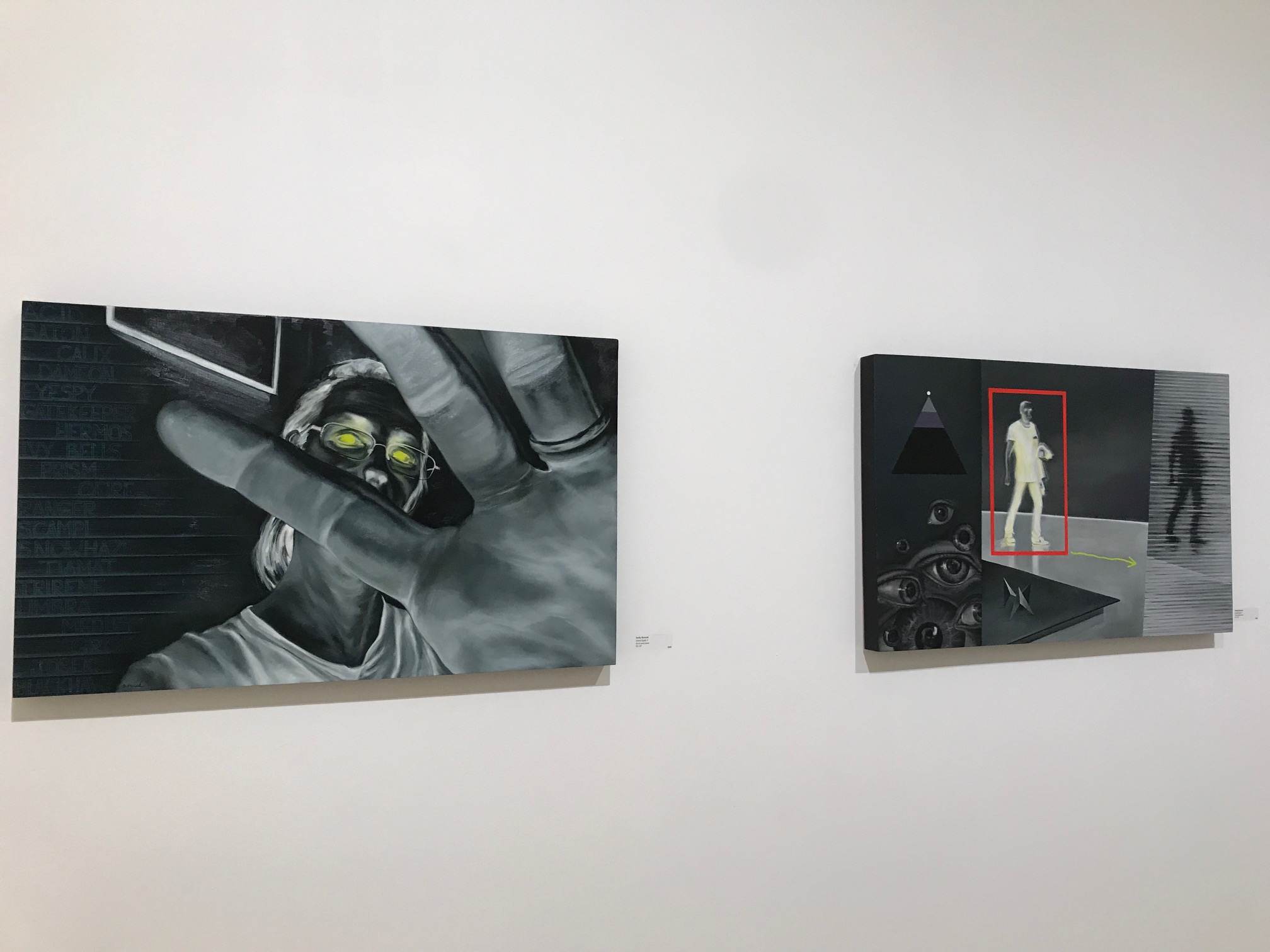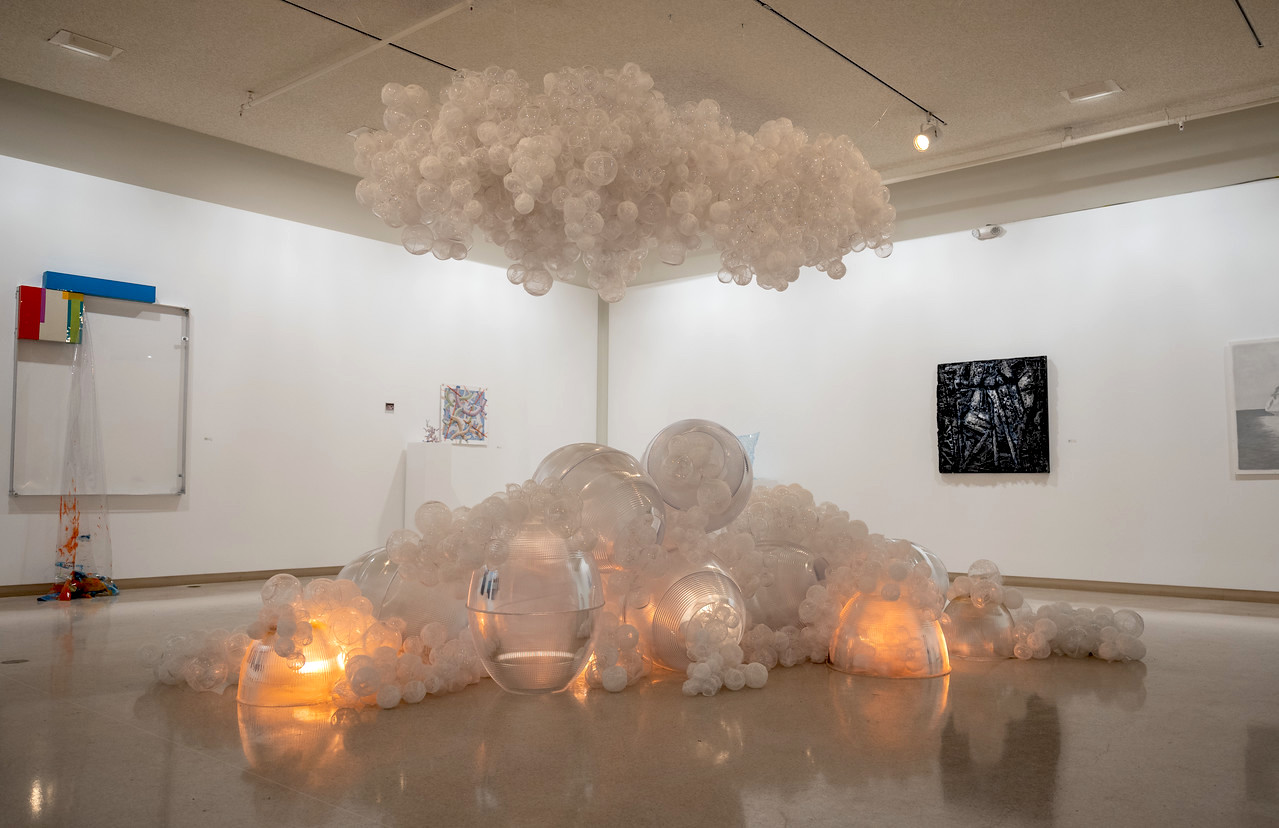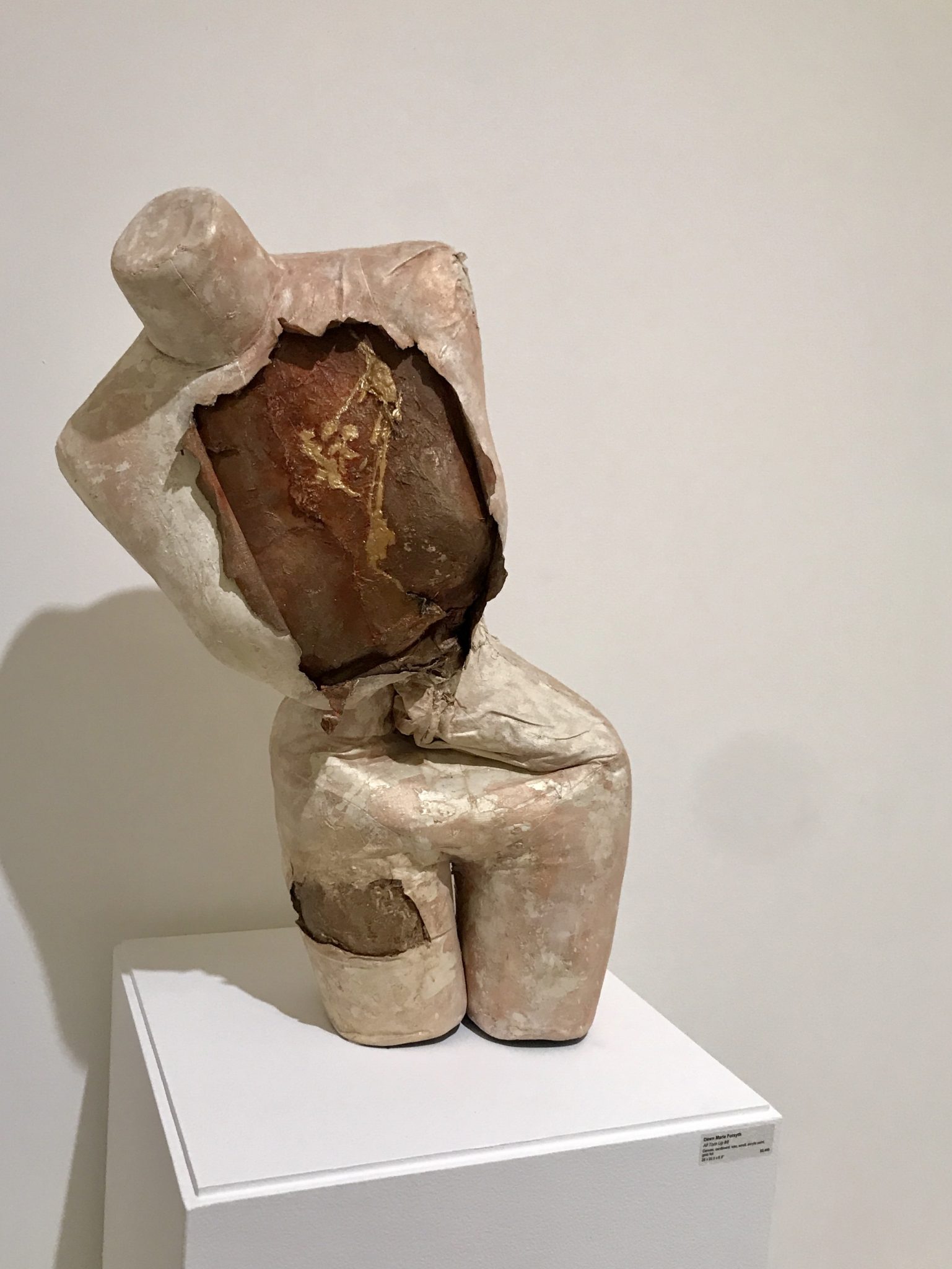In the haunting group show The Nothing That Is, now at the Brand Library and Art Center, curators Yaron Dotan and Christine Rasmussen have shaped a powerful exhibition that takes as its inspiration a Wallace Stevens poem that suggests viewers behold “nothing that is not there, and the nothing that is.” The exhibition includes mixed media, painting, and sculptural pieces, as well as a multi-image video installation, that are thought-provoking and rich. The viewer feels submerged in a world that emphasizes the contemplation of aloneness in many pieces; while others seem supercharged to bring us to light and communion.
Holly Boruck’s oil on wood panel paintings use a restricted palette to present ghostly, resonant images of technological observation and surveillance. Arminee Chahbazian exhibits stunningly precise graphite and colored pencil works with glass beads that are shaped to balance a sense of loneliness with hopeful survival. The beauty of the isolated landscapes is merged into the sensation that they may exist only in the mind and through dreams. Monochromatic, these works are both tributes to and disruptions of, natural beauty.

Holly Boruck
The sculptural mixed media works of Chelsea Dean includes found objects from abandoned desert homesteads, to which she adds elements of gold leaf. She pays honor and homage through these objects, her drawings, collage, and printmaking. Discarded elements are ghostly treasures in Dean’s hands, both repurposed and reimagined — the stuff of fantasy.
Artist Monica Wyatt also uses discarded and repurposed materials in her sculptures – stones and wood repurposed into ladder-like sculptures in “Continuum,” as well as in “When Shadows Chase the Light,” her truly radiant, enormous bubble balls of light that glow with joy in the main gallery space. Both focus not on the elegiac but on the wondrous quality of new life from reimagined organic materials. If Dean beautifully honors and re-dreams the past, Wyatt translates a truly glorious sense of communion for the future, one that could be hopeful and connected. She offers a rectifying of lost purpose, or a visual redemption story, if you will.

Monica Wyatt
Co-curator Dotan offers ink and gesso drawings that are dizzying and spectacular; black and white images that seem to vibrate with motion, optical illusions that highlight the wintery view of the world that permeates many of the exhibition pieces. His works focus on both disconnection and intimacy. A similar sensation of disconnection and intimate relationship is evoked in the very different mixed media sculptures of Dawn Marie Forsyth, which recognize the temporary status of the human body through contorted, distorted, and reworked body forms that highlight imperfection over perfection, and define beauty through struggle.

Dawn Marie Forsyth
In contrast, Jenn Fuentes work illuminates interaction among her subjects, as in “Subway,” a lush human landscape. Here human connectedness is almost spiritual, and the importance of that connection is the ultimate antidote to “nothingness.”
Larry Kagan’s work is an astonishing use of shadows and sculpture – an almost impossible-seeming construct of wall-mounted steel that uses light to create almost unimaginably perfect shadow art. Ephemeral and amazing, it is something you simply have to see to believe, whether it is the body of a man emerging from an abstract tangle of welded steel or a pointing finger requiring us to look closely in “Yes You.”

Larry Kagan
Mixed media sculptural collaboration by Michael Henry Hayden and Anthony Lepore is spare and thought-provoking, so too are the excessivist, large-scale works of Kaloust Guedel, who uses industrial plastic, acrylic, and the more transitory application of light itself to create thematic variations that shift unexpectedly before a viewer’s eyes. Both Hayden and Lepore, as well as Guedel, use sculptural forms to lead their viewers past their own creations. Guedel’s work uses exciting drapings and shadows to provide an inward glow and resonance. Here his works served as a perfect counterpoint to pieces such as co-curator Rasmussen’s oil paintings. Her “Ave 20” uses light and empty space within a spare urban landscape that is dreamlike and mysterious; evocative of a portal to another dimension. Her perfectly rendered images draw the viewer into that street, into an architectural beauty that echoes the natural beauty of nature.
Andrew Paine’s dark and dense mixed media works are both surface and substance, highly textural, archeological layers of art. In contrast, Colin Roberts’ sculptural plexiglass and glue works such as the light rainbow that is “Holograph Pillow” are dreamy and surreal, futuristic and ghostly; if you drifted to sleep on these pillows, where would you wake? And to what?

Colin Roberts
Linda Vallejo’s images, taken from antique postcards and manipulated/reimagined, glow with an impassioned deep red. Her “San Juan Capistrano I & II” seethe with the bloodshed to establish these missions, and evoke both loss and the revisions of forgotten history.
Exhibiting both lustrous, pin-hole views through lightboxes one must squint to see or displaying a sprawling, fantastical sculptural narrative in her “Going Under,” Josephine Wister Faure sets a metaphorical stage for the imagination. Her mixed media installation includes a hand reaching from a pile of fine white sand, through which a bright red purse is also visible. Is this a buried body? A woman in dire need of help? Metaphor for the innate nothingness of the world? An example of someone’s disregard for the truth as in “nothing to see here, move on?” A wake-up call for the planet? The work is riveting, and like every piece in this exhibition, it is well-worth considering meaning, and reveling in the possibilities.
Dotan and Rasmussen’s curation here is stellar, offering an exhibition requires viewers to dig in deep – and extract the mystery and meaning within.
The Nothing That Is
Brand Library and Art Center
1601 West Mountain Street
Glendale, CA 91201
November 16-January 17, 2020


